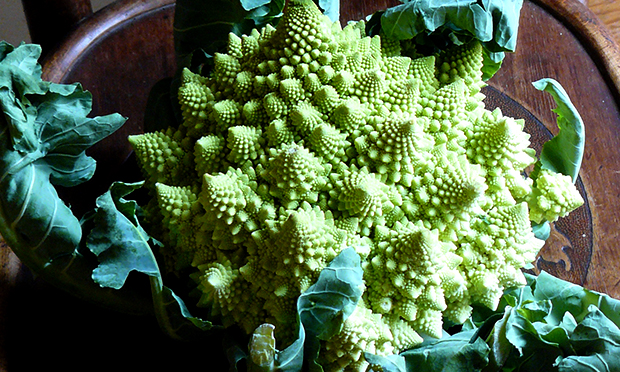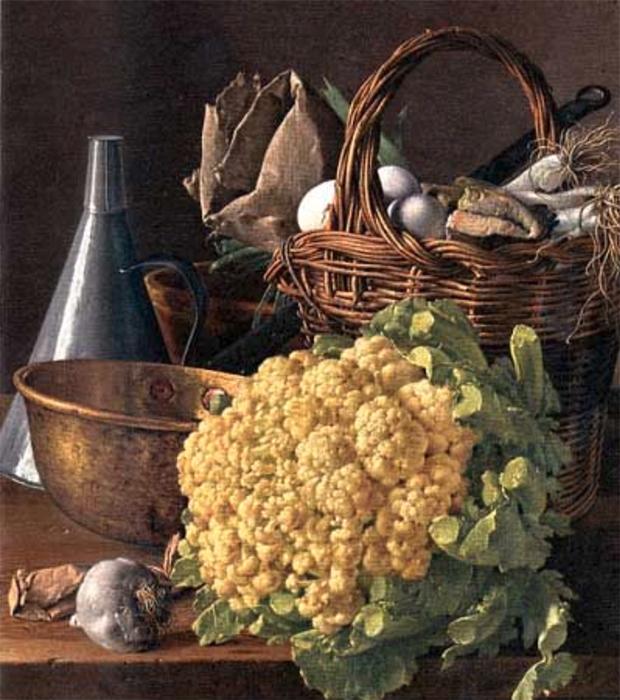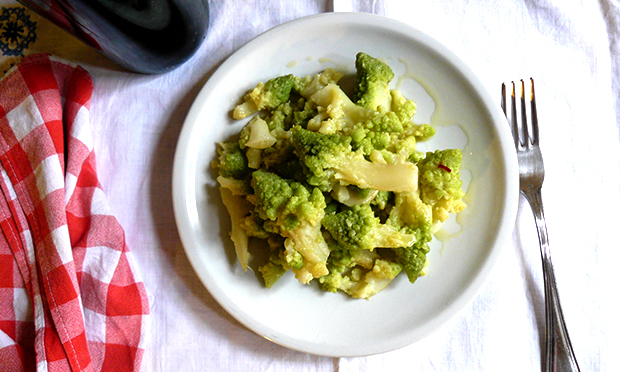Broc and roll

This column identifies with the stroppy child rather than the anxious insecure mother in the well-known New Yorker cartoon.
Mother: “But it’s broccoli darling…”
Child: “I say it’s spinach and I say the hell with it.”
Getting small children to enjoy their five a day means you have to make your vegetables look good, smell good and taste good. It’s hard to imagine anyone achieving this with the inexplicably trendy cauliflower.
The cauliflower cheese of my childhood was a dismal dish, with the living daylights boiled out of the unfortunate vegetable, drenched with a sauce of milk and flour tasting of nothing, covered with scrapings of rancid stale cheddar cheese and incinerated to everything’s disadvantage.
Even Felicity Cloake’s heroic account in the Guardian of her attempts to find the perfect version left me unmoved.

The light bulb moment came with the above still life painted in Madrid in 1777 by Luis Meléndez – the apotheosis of the cauliflower, a massive luminous globe of ivory tinged with gold, and a shopping basket with paper-wrapped salt cod (a piece escaped to make the point clearly), leeks and eggs, and in the background a can of olive oil, some garlic and a little packet of spices on the left.
At first sight this seems to be just another random pile-up on a kitchen table, but to my delight it turned out to be a visual recipe for bacalao con coliflor, a dish traditionally prepared in Galicia for the Noche Buena feast on Christmas Eve.
Cooked salt cod, cauliflower, hard-boiled eggs and leeks are assembled in a baking dish and flooded with olive oil pungent with lots of garlic.
The drab ingredients are transformed by the bright yellow of the egg yolks, and the viscous glow of the greenish yellow oil, and it helps to add a few black olives and some of the green bits of the leeks.
Gently finished off in the oven, the flavours mingle so that the musty saltiness of the cod is a perfect foil to the mild vegetable and the bland eggs, with the garlicky oil acting as a sort of catalyst.
The little paper packet on the left probably had black peppercorns in it, which would have added bite and flavour.
Today, the internet is flooded with recipes for this traditional dish, often including potatoes and paprika, ingredients that Meléndez never painted, perhaps because they were not in common use in Madrid at that time.
The paprika adds a lurid glow to the dish that it doesn’t really need, I prefer to cook the subtle scheme laid down so clearly by Meléndez.
The still lifes of Meléndez would have been appealed to Carlos III, who enjoyed ruling Naples until he was reluctantly obliged, on the death of his brother, to move to Madrid as king of Spain. Leaving Naples, the pleasure city of Europe, with its relaxed cheerfulness, for the rigid formalities and harsh climate of Madrid, was depressing.
Carlos and his family must have appreciated the food depicted by Meléndez, at a time when French fashions in art, literature, manners, fashion and above all gastronomy were imposed universally.
So what was going on in Madrid? The rest of Europe seemed to endorse the tyranny of French cuisine, but under the surface of Spanish and some Italian cookery books lurked subversive ingredients and recipes, which help explain these homely domestic still lifes that many rich aristocratic patrons loved to hang on their walls.
Much earlier, in 17th-century Naples, Antonio Latini, author of Lo Scalco alla Moderna, had masterminded banquets for visiting Spanish nobility, and always managed to sneak in a dish or two with garbanzos chickpeas, and chillies, and even some garlic, as a civilised, not mocking, deference to the tastes of important guests.
A century later Vincenzo Corrado in Naples was even more subversive. The table settings in his book Cuoco Galante were in the fashionable French Rococo style, his recipes had French names, but used the produce of southern Italy in his own idiosyncratic way, partly traditional, partly innovative, with a cheerful disregard of French conventions.
In 1785 he wrote a book of vegetable recipes, Del Cibo Pitagorico, which fits in beautifully with our current enthusiasm for vegetables and fruit.
But vegan he was not, for just about every recipe, except those for the Catholic church’s lean or non-meat days, calls for meat or chicken stock, or fishy ingredients, as in some of Italy’s ways of handling other members of the cabbage family.

Rachel Roddy has given us, in the Guardian as well as her blog ‘Rachel Eats’, a range of delicious Italian ways with broccoli, a member of the brassica family, of which cauliflower is just one, where the flower buds are what we eat.
Purple sprouting broccoli, or the green variety and the tenderstem version, can all be eaten either very lightly cooked, to keep just a little crunch (not al dente, that’s for pasta), or even better, reduced to a tasty mush, by tossing the half-cooked broccoli in olive oil, enlivened with garlic, anchovy and chilli, or pork sausages, which even the most stroppy child will enjoy.
You can have this with pasta, or a meal on its own.
How the cauliflower and related versions of the versatile cabbage/mustard family came to be domesticated after three or four million years in the wild is obscure.
The romanesco cauliflower is a magical mind-boggling mystery, with its greeny-yellow florets growing in a beautiful circular pattern, the Fibonacci spiral, a sequence of numbers you get from adding 1 to the next number, 2, which gets you 3, then adding that to the previous number, which comes as 5, and so on, which can be plotted as a beautiful spiral like a seashell or the pattern of sunflower seeds or the curve of a cresting wave.
We have no notion why of all the cabbages this one was the only one to be endowed with such mathematical and aesthetic appeal.
Maybe the combined powers in sixteenth-century Calabria of a mad mathematician and an obsessive botanist made this happen?
Today, we can enjoy the sight of them in our kitchens and markets, and try out the many tasty recipes.
